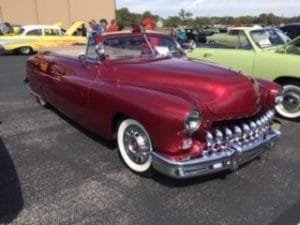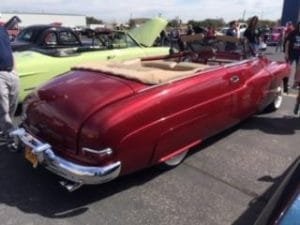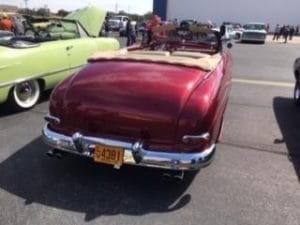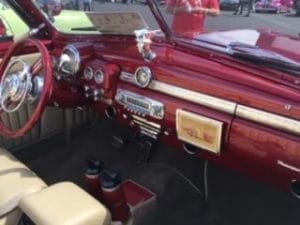Featured is a customized 1949 Mercury Eight Convertible also known as the “Lead Sled”. The 1949 to 1951 Mercurys became the favorite cars of 1950s customizers.
Lead Sled refers to the car having a heavy body and modified suspension giving the vehicle a lower stance. The word “lead” came from the fact that in modification lead was used as a body filler. This was prior to the introduction of “bondo.” The added lead obviously made the body heavier.
Some automobile models are turned into hot rods and others into “Lead Sleds.” In a large way, the lead sled is also a hot rod of a somewhat different sort. Lead sleds are considered to be modified full size American cars usually from 1949 and the early 1950’s.

The first Lead Sled was built in 1949 by designer George Barris. Among other vehicles, Barris designed and built several automobiles for Hollywood movies including North By Northwest and The Time Machine.
First Postwar Design
When did postwar civilian production begin. Priority assistance was given the automotive industry, Apr. 5, 1945, for purchase of tools and equipment and for construction work. After the surrender of Germany the industry was authorized to make approximately 200,000 units during the remainder of 1945All quota limitations on the production of automobiles and trucks were revoked by the War Production Board within 10 days of the Japanese surrender.

Automakers brought out their new postwar designed vehicles near the end of the 1940’s. As an example Chevy’s new Advance Design trucks for 1948 were the first completely restyled General Motors vehicles introduced after World War II. Chrylser unveiled their new designs in 1949. Studebaker brought out their new designs in 1947.
The 1949 Mercury’s represented the first postwar designs. This was the case with other Ford Motor Company models as well.
1949 Mercury Eight Specifications
The stock 1949 Mercury Eight came with a 255 cubic inch flat head V-8 engine delivering 112 HP.
Transmissions were a three speed manual and a four speed manual with overdrive.
Brakes were four wheel hydraulic drums.
The wheelbase was 118.0 inches and the car’s overall length was 207 inches.The 1949 Mercury’s weight averaged 3,321 to 3,800 pounds.
 Production numbers for the 1949 Mercury model year sedan were 156,000. Coupe figures were 120,000 and the Mercury convertible models only about 17,000. This was quite higher than production in 1948 with sedan production totals of about 41,000 units. About 17,000 coupes were built and about 7,500 convertibles.
Production numbers for the 1949 Mercury model year sedan were 156,000. Coupe figures were 120,000 and the Mercury convertible models only about 17,000. This was quite higher than production in 1948 with sedan production totals of about 41,000 units. About 17,000 coupes were built and about 7,500 convertibles.
Related Auto Museum Online articles and photos are found on the links below..
Reference material for this articles includes..55 Years of Mercury: The Complete History of the Big “M” by John Gunnell..Modern Classics The Great Cars of the Postwar Era by Rich Taylor.
1949 Mercury Collector Cars
Ford’s goal was to have car buyers perceive the Mercury as a lower priced Lincoln rather than a higher priced Ford.The entire 1949 through 1951 Mercury Eight models are popular collector’s cars which hold their value well. The most popular model is the 1949 wagon.
 Some average auction sale prices on 1949 Mercury’s as of this date are as follows. These are average sales prices. Sedan about $18,000…coupe about $29,000…convertible about $59,000 and the woody wagon about $66,000.The customized Lead Sleds are currently priced in a wide range from the mid twenties to the $60,000 area.
Some average auction sale prices on 1949 Mercury’s as of this date are as follows. These are average sales prices. Sedan about $18,000…coupe about $29,000…convertible about $59,000 and the woody wagon about $66,000.The customized Lead Sleds are currently priced in a wide range from the mid twenties to the $60,000 area.
As with all classic and vintage cars and trucks, the actual sales prices will vary a good amount depending on condition and extent of restoration.
(Article and photos copyright Auto Museum Online)
